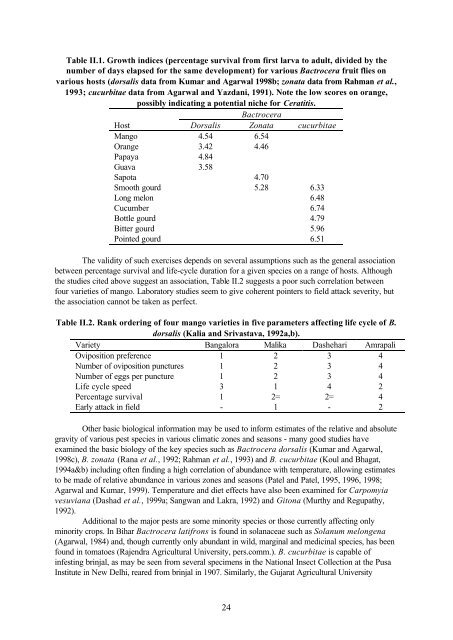“Key Informant Survey” of Production, Value, Losses and ... - DfID
“Key Informant Survey” of Production, Value, Losses and ... - DfID
“Key Informant Survey” of Production, Value, Losses and ... - DfID
Create successful ePaper yourself
Turn your PDF publications into a flip-book with our unique Google optimized e-Paper software.
Table II.1. Growth indices (percentage survival from first larva to adult, divided by the<br />
number <strong>of</strong> days elapsed for the same development) for various Bactrocera fruit flies on<br />
various hosts (dorsalis data from Kumar <strong>and</strong> Agarwal 1998b; zonata data from Rahman et al.,<br />
1993; cucurbitae data from Agarwal <strong>and</strong> Yazdani, 1991). Note the low scores on orange,<br />
possibly indicating a potential niche for Ceratitis.<br />
Bactrocera<br />
Host Dorsalis Zonata cucurbitae<br />
Mango 4.54 6.54<br />
Orange 3.42 4.46<br />
Papaya 4.84<br />
Guava 3.58<br />
Sapota 4.70<br />
Smooth gourd 5.28 6.33<br />
Long melon 6.48<br />
Cucumber 6.74<br />
Bottle gourd 4.79<br />
Bitter gourd 5.96<br />
Pointed gourd 6.51<br />
The validity <strong>of</strong> such exercises depends on several assumptions such as the general association<br />
between percentage survival <strong>and</strong> life-cycle duration for a given species on a range <strong>of</strong> hosts. Although<br />
the studies cited above suggest an association, Table II.2 suggests a poor such correlation between<br />
four varieties <strong>of</strong> mango. Laboratory studies seem to give coherent pointers to field attack severity, but<br />
the association cannot be taken as perfect.<br />
Table II.2. Rank ordering <strong>of</strong> four mango varieties in five parameters affecting life cycle <strong>of</strong> B.<br />
dorsalis (Kalia <strong>and</strong> Srivastava, 1992a,b).<br />
Variety Bangalora Malika Dashehari Amrapali<br />
Oviposition preference 1 2 3 4<br />
Number <strong>of</strong> oviposition punctures 1 2 3 4<br />
Number <strong>of</strong> eggs per puncture 1 2 3 4<br />
Life cycle speed 3 1 4 2<br />
Percentage survival 1 2= 2= 4<br />
Early attack in field - 1 - 2<br />
Other basic biological information may be used to inform estimates <strong>of</strong> the relative <strong>and</strong> absolute<br />
gravity <strong>of</strong> various pest species in various climatic zones <strong>and</strong> seasons - many good studies have<br />
examined the basic biology <strong>of</strong> the key species such as Bactrocera dorsalis (Kumar <strong>and</strong> Agarwal,<br />
1998c), B. zonata (Rana et al., 1992; Rahman et al., 1993) <strong>and</strong> B. cucurbitae (Koul <strong>and</strong> Bhagat,<br />
1994a&b) including <strong>of</strong>ten finding a high correlation <strong>of</strong> abundance with temperature, allowing estimates<br />
to be made <strong>of</strong> relative abundance in various zones <strong>and</strong> seasons (Patel <strong>and</strong> Patel, 1995, 1996, 1998;<br />
Agarwal <strong>and</strong> Kumar, 1999). Temperature <strong>and</strong> diet effects have also been examined for Carpomyia<br />
vesuviana (Dashad et al., 1999a; Sangwan <strong>and</strong> Lakra, 1992) <strong>and</strong> Gitona (Murthy <strong>and</strong> Regupathy,<br />
1992).<br />
Additional to the major pests are some minority species or those currently affecting only<br />
minority crops. In Bihar Bactrocera latifrons is found in solanaceae such as Solanum melongena<br />
(Agarwal, 1984) <strong>and</strong>, though currently only abundant in wild, marginal <strong>and</strong> medicinal species, has been<br />
found in tomatoes (Rajendra Agricultural University, pers.comm.). B. cucurbitae is capable <strong>of</strong><br />
infesting brinjal, as may be seen from several specimens in the National Insect Collection at the Pusa<br />
Institute in New Delhi, reared from brinjal in 1907. Similarly, the Gujarat Agricultural University<br />
24

















